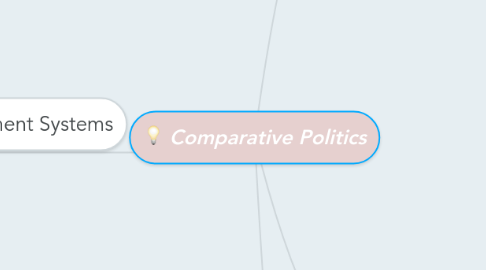
1. Government Systems
1.1. Presidential System
1.1.1. Fused Executive
1.1.2. Mutual Independence
1.1.3. Advantage
1.1.3.1. More choices for voters
1.1.3.2. Accountability
1.1.3.3. Congressional Independence
1.1.4. Disadvantages
1.1.4.1. Minority Government
1.1.4.2. Congressional Government
1.1.5. United States and Nigeria
1.1.6. Brazil
1.1.6.1. Corporatism- state has active role with organizing groups and mediating them
1.1.6.2. Authoritarian
1.1.6.2.1. Repressive of freedoms
1.1.6.3. Military Regime
1.1.6.4. Weakened by fragmented party system and need to work with shifting coalitions
1.1.6.5. BiCameral
1.1.6.5.1. Chamber of Deputies
1.1.6.5.2. Upper House: Senate
1.2. Parliament
1.2.1. Dual Executive
1.2.1.1. Head of Government
1.2.1.2. Head of State
1.2.2. Mutual Dependence
1.2.2.1. Executive must have minority
1.2.2.1.1. Fusion of executive and legislative powers
1.2.2.2. Can dissolve legislation
1.2.3. Advantages
1.2.3.1. Prime Minister first among equals
1.2.3.1.1. Member of legislature
1.2.3.1.2. Leader of Majority Power
1.2.3.2. Mutual Dependence
1.2.4. Disadvantages
1.2.4.1. Potential of Government Instability
1.2.4.1.1. More parties leads to unstable coalition
1.2.5. United Kingdom
1.2.5.1. Unwritten Constitution
1.2.5.2. Parliament can't sit more than five years
1.2.5.3. Parliament can pass vote of no confidence
1.2.5.4. Government is responsible to Parliment
1.2.5.5. Brexit
1.2.5.6. House of Lords
1.2.5.6.1. 700 members
1.2.5.7. House of Commons
1.2.5.8. SMD plurality
1.2.5.8.1. Disproportional outcomes
1.2.5.8.2. Strategic voting
1.2.5.8.3. Most votes win
1.2.6. Germany
1.2.6.1. Bicameral
1.2.6.1.1. Bundestag
1.2.6.1.2. Bundesrat
1.2.6.2. Head of Gov- Chancellor
1.2.6.3. Head of State-President
1.2.6.4. Mixed Member Proportional Representation
1.2.6.4.1. 1/2 SMD/Plurality
1.2.6.4.2. 1/2 PR/Party List
1.2.6.4.3. Voters Cast two votes
1.3. Semi Presidential
1.3.1. Dual Executive
1.3.1.1. Head of government
1.3.1.1.1. Fused with and is responsible with legislature
1.3.1.1.2. Parliament
1.3.1.2. Head of State
1.3.1.2.1. Presidential
1.3.2. France
1.3.2.1. National Assembly- main legislative body
1.3.2.1.1. Elected from citizens
1.3.2.2. Senate
1.3.2.2.1. Upper house
1.3.3. Russia
1.3.3.1. Power in Politburo and with general secretary
1.3.3.2. Perestroika
1.3.3.2.1. USSR democratizing
1.3.3.3. Kremlin
1.3.3.3.1. Semi-Presidential
1.3.3.4. Suppraregions
1.3.3.5. Federal Assembly
1.3.3.5.1. DUMA
1.3.3.5.2. Federation Council
1.3.3.6. Run Off Election
1.3.3.7. Corruption
1.3.3.8. Mixed Member Proportional
1.4. Communism
1.4.1. Core of Human relations is economic
1.4.2. Central Planning
1.4.3. Nationalization of Production
1.4.4. Collectivization of Agriculture
1.4.5. China
1.4.5.1. Corruption
1.4.5.2. Chinese Communist Party
1.4.5.2.1. State Council
1.4.5.2.2. National People's Congress
1.4.5.2.3. Supreme People's Court
1.4.5.2.4. Supreme People's Procurator ate
1.4.5.3. State
1.4.5.3.1. Presidential (ceremonial)
1.4.5.4. Military
1.4.5.5. Inequality and urban/rural divides
2. Constitution
2.1. Political Ideology
3. State
3.1. Government Institutions
3.1.1. Extractive
3.1.2. Administrative
3.1.3. Coercive
3.1.4. Legal
3.2. Success
3.2.1. Sovereignty
3.2.2. Legitimacy
3.3. Failing
3.3.1. No legitimacy
3.3.2. Can't provide public services
3.3.3. Corrupt
3.3.4. Nigeria
3.3.4.1. Presidentialism
3.3.4.1.1. Directly elected and hard to remove
3.3.4.1.2. Centralized executive authority
3.3.4.2. Institutions
3.3.4.2.1. Bicameral
3.3.4.3. Federalism
3.3.4.3.1. Hyperfederalism
3.3.4.4. Election Issues
3.3.4.4.1. Security
3.3.4.4.2. Corruption
3.3.4.5. PDP
3.3.4.5.1. Christian party strongest in the South
3.3.4.6. WEAK
3.3.4.6.1. Most populous country and largest exporter in Africa but weak-
3.3.4.7. Praetorianism
3.3.4.7.1. Military tried to intervene when government is in chaos
